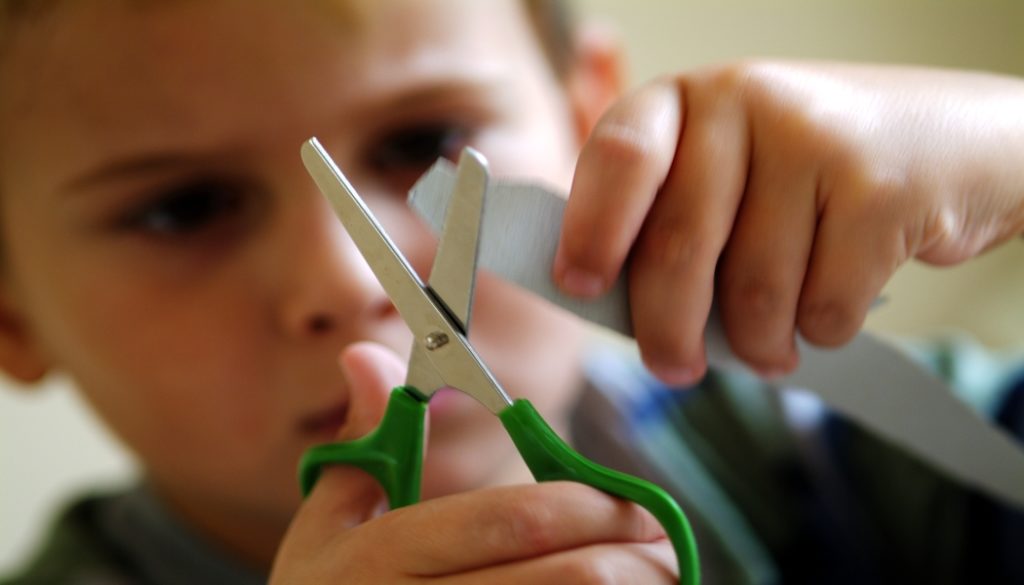Anu had an obsessive-compulsive phase when she was around 20 months old: she insisted us on opening any package as soon as we received it (online shopping you see). I was surprised by Anu’s fascination and insistence, but soon realised her attraction was not with the content or the discipline of opening the packet immediately, but it was with the scissors and scissoring.
Soon the insistence of us opening graduated to a demand for her opening the packet. But we were scared of giving her the sharp metallic scissors :-(.
So a few weeks after Anu’s 2nd birthday, I got her a pair of ‘kid friendly’ scissors. Watching her learn the skill of using a scissor, I realised that scissoring is an acquired skill and requires strength and coordination!
Using scissors in an acquired skill

source: https://goo.gl/gtX34N
Anu’s joy knew no bound when she got her shiny orange scissor. Anu has a plastic scissors, with blunt ends. I gave her a tracing worksheet to practice the very first time (facepalm), thinking soon we would have a cutout to go on the fridge!
What came next was an eye-opener for me. Firstly, Anu took some time to hold the scissors between her index finger and thumb. She had to focus really hard to ensure the scissor remained firmly between her fingers and pointed away from her palm.
Then she practised for some time opening and closing the scissors with her three fingers. It looked as if she had discovered a few found strength and agility in those fingers.
After trying for many minutes, she asked me to use the scissors. I slowly showed her how to put fingers in the holes and do “snip snip”.
She tried again and was kind of frustrated why she could not do it like her Aai. But frustration was momentary. She worked at it still, relentlessly, till she was a bit more confident. That was day 1 of using scissors.
Cutting with a scissor is a complex task … Anu’s learning continued
For the next couple of days, she just practised holding the scissors between her fingers and opening and closing it. Till she gained confidence, I was doing a lot of paper cutting for her (after every few attempts she would ask me to cut, she was keenly observing and processing my moves).
Then she started cutting on the tracing sheet. It was not a success at first. I realised the paper was not stiff enough to cut easily. Even I struggled to cut it in a clean stroke. So I gave her the thick glossy paper. Thanks to all the pamphlets that come in the newspaper that usually go straight to the waste paper pile. The glossy paper was a better choice, and soon Anu was able to cut paper with the scissors. For rest of the week, she was relentlessly practising cutting paper. She could still not hold the paper in one hand and cut with other. So, I would hold the paper, and she would cut. She eventually started holding the paper in her hand after a couple of weeks. And so we were cutting!
What skills are required to use scissors
What looks like a simple act of cutting with scissors is actually a complex task for kids. It involves strength of finger muscles, coordination between dominant hand holding the scissors and non-dormant hand holding the paper (bi-lateral co-ordination) as well as hand-eye coordination.
A child around 2-3 years of age, has fine motor skills (involving synchronisation of hands & fingers with eyes) required for cutting with scissors are moderately developed. So you can introduce scissors around that age. But remember each child may learn the skill at his pace.
You can engage your child with various activities (a.k.a. pre scissor skills) to help improve fine motor skill required for cutting. Some of the favourite objects/Montessori activities for strengthening fine motor skills are:
- Small tongs to pick up objects
- Clothespins for lining clothes
- Tweezers for picking/separating small objects
- Droppers for transferring liquids
Child-friendly scissors & paper cutting for kids

source: https://goo.gl/zQUvtT
Use lightweight and kid safe scissors (blunt scissors or the one with round tips). Preferably start with plastic scissors that can cut only paper and card and nothing else.
Buy kid-friendly scissors:
Following are some of the popular brands for buying child-safe scissors:
Use tracing sheets for paper cutting activity:
Start with thick and stiff paper or age appropriate tracing sheets (click here to know how to introduce scissor skill practice sheets). There are plenty of options online (especially on Pinterest) which you can print for free and use. Following are some of the printable scissor skill practice sheets from:
Scissoring has various benefits
Cutting with scissors is one of the favourite activity of many toddlers/preschoolers. This fun and engaging activity has many benefits for the young ones.
Practising with a scissor helps develop fine motor skill. It involves combining the movement of the thumb, index finger and middle finger, thus improving strength and dexterity of the fingers. Also, as the child holds the paper with one hand and cuts in controlled motion with a scissor in another, stability in the child’s shoulder and wrist improves. It also promotes hand-eye coordination and attention.
Scissoring – A complex task to learn but so much fun
Scissoring skill, what we adults don’t realise, is a complex task for the kids to learn. However, it is so much fun once they learn the knack of it. It is a very engaging activity for the kids. And a useful one to develop fine motor skills.






Leave A Comment